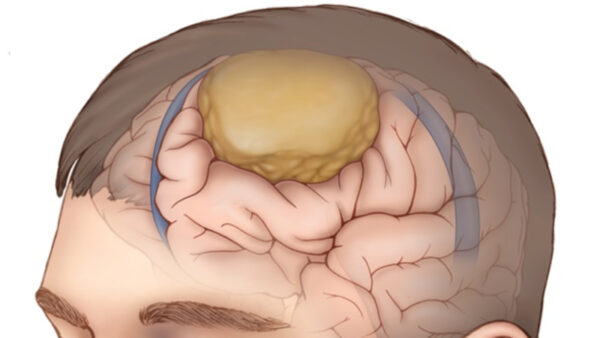Last updated on September 21, 2023
Tumors, whether benign or cancerous, elicit fear. The worry is not unwarranted, considering how lethal tumors can get, more so without prompt diagnosis and treatment. Benign tumors’ outlook is less deadly than malignant (cancerous) counterparts. This is because the non-cancerous tumors do not spread to other areas or invade surrounding tissues. Nonetheless, the symptoms and impacts can still be overwhelming and even life-threatening. This is because they can cause significant pressure on vital structures like nerves and blood vessels. Among such tumors is meningioma.
Meningioma tumors develop from the membranes that surround the spinal cord and brain. The membranes are referred to as meninges, and their primary purpose is to protect your brain and spinal cord. Meningiomas are slow-growing non-cancerous tumors. This means they can remain asymptomatic for an extended period. When symptoms show, the tumors have grown big enough to press the surrounding structures, causing compression that could interfere with normal functions. Meningioma symptoms vary, considering the location and its size. The common symptoms include:
- Nausea
- Vision changes (blur or double vision)
- Impaired hearing (ringing in ears or hearing loss)
- Loss of smell
- Headaches (worsens with time)
- Seizures
- Impaired balance and coordination
- Numbness, tingling, or weakness in legs and arms
- Concentration and thinking difficulties
- Memory loss
- Personality changes
Since meningioma grows slowly, you may not experience notable symptoms that necessitate immediate treatment. However, as they grow bigger, they can cause serious problems and, if untreated, could be fatal. Moreover, while initially benign, the tumors could also be cancerous. The concerns emphasize the need for prompt, professional attention. Prompt diagnosis and treatment can help improve meningioma prognosis. This includes lifestyle adjustment considering the likely cause of the tumors. Let’s look at the common factors that could lead to meningioma or increase its risks.
Meningioma risk factors
-
Age
Meningioma is prevalent in older adults and commonly diagnosed in individuals aged 65 or older. This is mainly because the tumors can easily go undetected, considering the slow-growing nature that doesn’t show apparent symptoms. Many people are likely to have developed meningioma, which remains asymptomatic for years. As they steadily grow over the years, the tumors press the structures and cause gradual symptoms development.
Aging can’t be stopped, and while it is a risk factor, it doesn’t mean meningiomas are inevitable after hitting 60+ years. It only means that the risk of being diagnosed with the tumors is high, but they can be slowed, treated, or surgically removed, considering your overall health and the symptoms.
-
Genes
Genetic predisposition is a common risk factor for many conditions, meningioma included. Like aging, genes are unmodifiable but don’t mean it is inevitable that you’ll develop tumors. Meningiomas tend to develop sporadically and have rare genetic predispositions.
Individuals at higher meningioma risks based on genes have hereditary conditions like multiple meningioma syndrome and neurofibromatosis type 2. Such genetic considerations mean a person can develop meningioma at an early age.
-
Gender
Females are more susceptible to developing meningioma. This is mainly associated with hormonal concerns. Hormones, particularly estrogen, androgen, and progesterone, are said to play a role in meningioma development. The tumors often have receptors for estrogen or progesterone and sometimes both on their cells’ surfaces.
Hormonal consideration is the reason the tumors are prevalent in many postmenopausal women. The tumors develop faster as women age. This is more so since meningioma grows much faster during periods like pregnancy when the female bodies produce more hormones. Besides the natural hormonal changes, hormone replacement therapy can also increase meningioma risk.
While women are twice as likely to develop meningioma, they are often non-cancerous. On the other hand, females and males are equally likely to develop more life-threatening cancerous meningioma.
Radiation exposure
A history of exposure to ionizing radiation, especially to the neck or head, increases brain tumor risks, including meningioma. For instance, if you’ve had radiation therapy to treat brain tumors like medulloblastoma, you are at higher risk of developing meningioma. Besides treatment therapies, you could also be accidentally exposed to radiation such as considering your surroundings and occupation. For instance, if you work in a nuclear power plant, food processing plant, or research laboratory, you are at high risk of accidental radiation exposure, which can lead to meningioma development.
Neurofibromatosis type 2 (NF2)
NF2 is a genetic disorder that causes non-cancerous tumor growth along the nervous system. The disorder results from a faulty gene that causes uncontrolled growth, hence the tumors. In most NF2 cases, the faulty gene is hereditary. This means a parent with a faulty gene is likely to pass it down to their child, increasing the disorder’s chances and consequential meningioma risk.
Meningioma has no clear cause. What’s clear is that the condition results from some cell alterations in the meninges that causes uncontrolled multiplication and tumor development. As highlighted above, the risk factors also show that most instances are unmodifiable. Besides extra caution to prevent radiation exposure, other risk factors are unpreventable. Even so, radiation exposure may be necessary, such as in treating primary brain tumors that, if left untreated, can significantly impact the quality of your life or shorten life expectancy.
It is not all doom and gloom; meningioma may not cause any/or severe symptoms. This means you could live with the tumors without treatment. If the symptoms are overwhelming, you can explore multiple treatment options. This includes radiation therapy, palliative care, craniotomy, neuroendoscopic, and endoscopic endonasal surgery.
The treatments consider the symptoms, your age, and overall health. This is more so since some treatments may pose more risks. For instance, if you are dealing with an uncontrolled preexisting condition like diabetes or high blood pressure, craniotomy, which is open surgery, may pose severe risks. In such a case, medication could be the best course of action. Medication, especially for smaller tumors, can help delay the growth by interfering with meningioma’s blood supply.
Prompt medical attention is recommended if you experience any symptoms or suspect you may have meningioma. When diagnosed early, you may benefit from non-invasive treatment to slow the tumor’s development.



















Be First to Comment